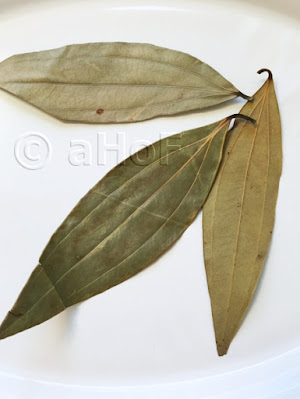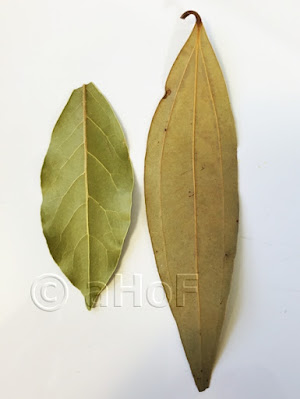 |
| Tej Patta or Tamal Patra leaves |
So imagine my surprise when not too long ago, I heard about "Indian Bay Leaf". I found that this is not a bay leaf as we know it at all, but something that looks sort of vaguely similar, and has been called "bay leaf" or even "Indian bay leaf," when if fact it has a closer relation to cinnamon. Wikipedia has this to say:
"Cinnamomum tamala, Indian bay leaf, also known as tejpat, tejapatta, Malabar leaf, Indian bark, Indian cassia, or malabathrum, is a tree within the Lauraceae family which is native to India, Bangladesh, Nepal, Bhutan, and China. It can grow up to 20 m (66 ft) tall."
Tej Patta - Cinnamomum tamala / C. tejpata / C. malabathrum
Called "Tej Patta" (among other spellings) in Hindi, "Tamalapatra" in Sanskrit, and called by other names in other languages or dialects, these leaves come from a tree that is in the Lauraceae family (as with our Bay Laurel leaves), but comes instead from a variety of cassia tree. Tej Patta leaves bear more resemblance in flavor to cinnamon or cloves, quite dissimilar to the piney, resinous flavor of bay laurel leaves.
 |
| Bay Laurel and Tej Patta Leaves - comparison |
Its usage in Indian cooking is mainly confined to the Mughlai (moog-lie) cooking style of the imperial courts of Delhi and Agra, in foods such as Biryani and Korma. In these regions it is used almost daily and is well known. If an Indian recipe calls for "bay leaf", it is automatically known, in India, by Indians, this refers to Tej Patta, or its misleading name: "Indian Bay Leaf."
Tej Patta is characterized by its three lengthwise veins instead of the bay laurel leaf's many branched veins off of one central vein. Note these differences in the photo at left. The size of the leaves in the packet I bought runs from just slightly larger than a mid sized bay laurel leaf upwards to about 6 or more inches in length.
If an Indian recipe calls for "bay leaf" or "Indian Bay Leaf", do not substitute a Bay Laurel leaf. Instead add just a little more cinnamon, or perhaps one clove or one allspice berry instead. The leaves are not so strongly flavored, and it is suggested that they be broken before adding to a dish to help increase potency of flavor. If in doubt, leave it out. A bay laurel leaf will lend the wrong flavors to the dish. Most things are available online these days, and true to form, I found them on Amazon.com.
My passion is teaching people how to create a harmony of flavors with their cooking, and passing along my love and joy of food, both simple or exotic, plain or fancy. I continue my journey in ethnic and domestic cuisines, continuing my journey to explore diverse culinary experiences and hopefully to start you on a journey of your own. Join me also at A Harmony of Flavors on Facebook, and Pinterest.

Thank you for posting this article. I stumbled across it as i was researching tejpata. I have been drumming this difference for years and find it aggravating that in most Indian recipes, when the use of tejpata is called for, they casually refer to it as bay leaf! In a recent purchase at an Indian grocery store, they were selling packages marked with English letters "Tejpata", followed by Bay Leaf, and inside the package were actually bay leaves (Laurus nobilis). I refer to tejpata as tejpata in my recipes written in English; after all, its Latin name is Cinnamomum tejpata. -Feryall R
ReplyDeleteI am so glad to hear from someone equally frustrated with the mistaken terms for bay leaf. I understand that Indians do refer to this leaf as "bay leaf," but it doesn't help when one doesn't know the difference. Another of my bugaboos is about black cumin, hard to find, and identified with at least two other seeds...don't even get me started!
Deletethis is so educating, thanks
ReplyDelete